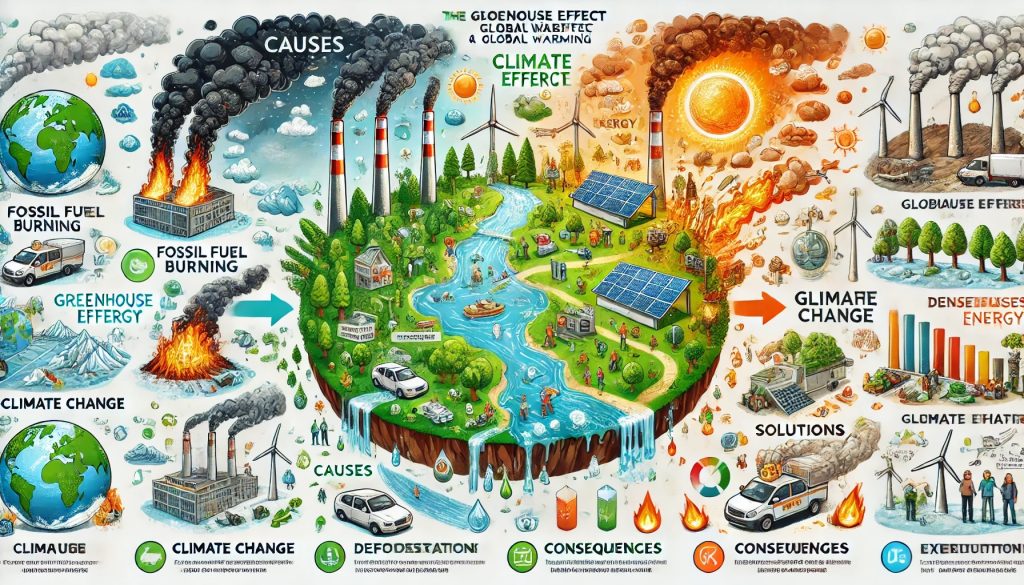Greenhouse Effect and Global Warming: Causes, Consequences, and Solutions
Introduction
The concepts of the greenhouse effect and global warming are two of the most critical environmental issues of the 21st century. Both are central to discussions about climate change, as they directly influence the planet’s temperature, weather patterns, and ecosystems. While they are often used interchangeably, they represent distinct but interconnected phenomena that are causing significant shifts in the Earth’s climate system. Understanding the science behind these processes, their causes, and their potential consequences is crucial in addressing one of the most pressing challenges facing humanity today.
This essay aims to provide a comprehensive overview of the greenhouse effect and global warming, their causes, impacts, and the solutions being proposed to mitigate their effects.

1. The Greenhouse Effect: A Natural Phenomenon
The greenhouse effect is a natural process that occurs when certain gases in the Earth’s atmosphere trap heat, preventing it from escaping back into space. This process is essential for life on Earth, as it keeps the planet warm enough to support ecosystems. Without the greenhouse effect, the Earth would be too cold to sustain most forms of life. However, human activities, particularly the burning of fossil fuels and deforestation, are enhancing this natural process, leading to global warming.
a. How the Greenhouse Effect Works
The Earth receives energy from the sun in the form of sunlight, which passes through the atmosphere and reaches the surface. Some of this energy is absorbed by the Earth’s surface, while the rest is reflected back into space. The Earth’s surface then emits this energy in the form of infrared radiation (heat). The greenhouse gases in the atmosphere, such as carbon dioxide (CO2), methane (CH4), nitrous oxide (N2O), and water vapor (H2O), absorb some of this infrared radiation and re-radiate it in all directions, including back toward the Earth’s surface. This process keeps the Earth’s temperature stable, allowing for the existence of life.
The primary greenhouse gases are:
- Carbon dioxide (CO2): Released primarily through the burning of fossil fuels (coal, oil, and natural gas) for energy production, transportation, and industrial activities.
- Methane (CH4): Emitted from sources such as livestock digestion, rice paddies, landfills, and the extraction and transport of natural gas.
- Nitrous oxide (N2O): Produced by agricultural and industrial activities, as well as the burning of fossil fuels.
- Water vapor (H2O): The most abundant greenhouse gas, though its concentration in the atmosphere is largely controlled by temperature rather than direct human activity.
b. The Role of Greenhouse Gases
The concentration of greenhouse gases in the atmosphere directly affects the strength of the greenhouse effect. While water vapor is the most significant greenhouse gas in terms of its contribution to natural warming, human activities have significantly increased the levels of CO2, CH4, and N2O, amplifying the greenhouse effect and raising global temperatures.
2. Global Warming: The Enhanced Greenhouse Effect
While the greenhouse effect itself is a natural and necessary process, human activities have increased the concentration of greenhouse gases in the atmosphere, leading to the enhanced greenhouse effect. This enhanced effect is responsible for global warming, a phenomenon characterized by a rise in the Earth’s average temperature due to an increase in the concentration of greenhouse gases.
a. Human Contributions to Global Warming
The primary drivers of global warming are human activities that release large amounts of greenhouse gases into the atmosphere. These activities include:
- Burning Fossil Fuels: The combustion of coal, oil, and natural gas for energy production, transportation, and industrial processes is the largest source of CO2 emissions.
- Deforestation: The clearing of forests for agriculture, urbanization, and logging reduces the number of trees that can absorb CO2 through photosynthesis. Deforestation also releases CO2 stored in trees and soil into the atmosphere.
- Agriculture: Livestock farming produces significant amounts of methane, while the use of synthetic fertilizers and the cultivation of rice paddies release nitrous oxide.
- Industrial Processes: Certain industrial activities, such as cement production and chemical manufacturing, emit large amounts of CO2 and other greenhouse gases.
- Waste Management: Landfills produce methane as organic waste decomposes in anaerobic (oxygen-free) conditions.
b. The Greenhouse Gas Emissions and Global Warming
The increased concentration of greenhouse gases leads to an enhanced greenhouse effect, trapping more heat in the Earth’s atmosphere and causing global temperatures to rise. This rise in temperature is commonly referred to as “global warming.”
3. Consequences of Global Warming
Global warming has far-reaching consequences for the planet’s ecosystems, weather patterns, and human society. Some of the most significant impacts include:
a. Rising Global Temperatures
The most direct effect of global warming is the rise in average global temperatures. According to the Intergovernmental Panel on Climate Change (IPCC), the global average temperature has already increased by about 1°C since the late 19th century, with much of this warming occurring in the last few decades. If current trends continue, the planet could warm by another 2 to 4°C by the end of the 21st century, depending on emissions scenarios.
b. Melting Polar Ice and Rising Sea Levels
One of the most visible effects of global warming is the melting of polar ice caps and glaciers. As temperatures rise, the ice in the Arctic and Antarctic regions is melting at an accelerated rate, contributing to rising sea levels. The melting of ice also decreases the Earth’s albedo (reflectivity), causing more sunlight to be absorbed by the surface and further accelerating warming.
Rising sea levels threaten low-lying coastal areas, including many major cities, and increase the risk of flooding, storm surges, and the loss of coastal ecosystems such as mangroves and coral reefs.
c. Extreme Weather Events
Global warming is contributing to the increasing frequency and intensity of extreme weather events. Some of the most notable examples include:
- Heatwaves: Higher global temperatures result in more frequent and intense heatwaves, which can lead to heat stress, droughts, and wildfires.
- Hurricanes and Typhoons: Rising sea surface temperatures provide more energy for tropical storms, resulting in stronger and more destructive hurricanes and typhoons.
- Flooding: Increased rainfall and the melting of glaciers and snow contribute to more frequent and severe flooding in many regions.
- Droughts: Some areas are experiencing prolonged droughts as a result of changing rainfall patterns and higher evaporation rates.
d. Disruption of Ecosystems
Global warming poses a significant threat to ecosystems and biodiversity. Rising temperatures, changes in precipitation, and extreme weather events are altering habitats and making it difficult for many species to survive. For example:
- Coral Reefs: Ocean warming causes coral bleaching, which weakens coral reefs and threatens marine biodiversity.
- Shifting Habitats: Many species are shifting their ranges in response to changing temperatures. Some may be able to migrate to more suitable environments, but others may face extinction if they cannot adapt.
- Ocean Acidification: Increased CO2 levels are leading to higher levels of carbonic acid in the oceans, making them more acidic and threatening marine life, particularly species with calcium carbonate shells, such as shellfish and corals.
e. Impact on Human Societies
Global warming also poses numerous risks to human health, security, and well-being. Some of these include:
- Health Risks: Heatwaves, air pollution, and the spread of vector-borne diseases (such as malaria and dengue) are direct threats to human health.
- Agricultural Productivity: Climate change is altering growing seasons, water availability, and crop yields, threatening food security, especially in developing countries.
- Migration and Displacement: Rising sea levels and extreme weather events may force millions of people to migrate from their homes, leading to climate refugees and potential conflicts over resources.
4. Mitigation and Adaptation Strategies
To address the challenges posed by the greenhouse effect and global warming, a combination of mitigation and adaptation strategies is necessary.
a. Mitigation
Mitigation strategies aim to reduce or prevent the emissions of greenhouse gases. Some key approaches include:
- Renewable Energy: Transitioning to renewable energy sources, such as solar, wind, and hydroelectric power, to reduce reliance on fossil fuels.
- Energy Efficiency: Implementing energy-saving technologies and practices in buildings, transportation, and industry.
- Carbon Sequestration: Increasing the storage of carbon in forests, soils, and oceans through reforestation, afforestation, and other land-use practices.
- Carbon Pricing: Implementing policies such as carbon taxes or cap-and-trade systems to incentivize the reduction of greenhouse gas emissions.
b. Adaptation
Adaptation strategies focus on reducing the impacts of global warming that are already occurring or are anticipated to occur. These include:
- Coastal Protection: Constructing seawalls, restoring wetlands, and implementing other measures to protect coastal communities from rising sea levels.
- Water Management: Developing strategies for efficient water use and improving infrastructure to cope with changing precipitation patterns.
- Agricultural Adaptation: Developing drought-resistant crops, improving irrigation, and altering farming practices to cope with changing climates.
Here are 10 Questions with their Answers related to the greenhouse effect and global warming:
1. What is the greenhouse effect?
Answer: The greenhouse effect is a natural process in which certain gases in the Earth’s atmosphere trap heat, preventing it from escaping into space. This process is essential for maintaining temperatures that support life on Earth. However, human activities, especially burning fossil fuels, have increased the concentration of greenhouse gases, intensifying the greenhouse effect and leading to global warming.
2. What are the main greenhouse gases responsible for global warming?
Answer: The main greenhouse gases responsible for global warming are:
- Carbon dioxide (CO2): Released primarily from burning fossil fuels.
- Methane (CH4): Produced by agriculture (especially livestock), landfills, and the oil and gas industry.
- Nitrous oxide (N2O): Released by agricultural practices and industrial activities.
- Water vapor (H2O): While it is the most abundant greenhouse gas, its levels are influenced by temperature, rather than human activities.
- Chlorofluorocarbons (CFCs): Synthetic compounds used in refrigerants and solvents, though their use has been reduced due to their role in ozone depletion.
3. How does human activity contribute to global warming?
Answer: Human activities, such as burning fossil fuels for energy, deforestation, industrial processes, and agriculture, significantly increase the concentration of greenhouse gases in the atmosphere. This leads to a stronger greenhouse effect, trapping more heat and causing the Earth’s average temperature to rise, a phenomenon known as global warming.
4. What is the difference between the greenhouse effect and global warming?
Answer: The greenhouse effect is a natural process that allows the Earth to retain heat and maintain a livable temperature. Global warming, however, refers to the enhanced greenhouse effect caused by the increase in greenhouse gases due to human activities, which is leading to a rise in global temperatures beyond natural levels.
5. What are the main consequences of global warming?
Answer: The main consequences of global warming include:
- Rising global temperatures leading to heatwaves and altered climate patterns.
- Melting of polar ice and glaciers, contributing to rising sea levels.
- Extreme weather events such as hurricanes, floods, and droughts becoming more frequent and intense.
- Disruption of ecosystems, leading to biodiversity loss and habitat destruction.
- Impacts on human health such as increased heat-related illnesses, spread of diseases, and air quality issues.
6. How do rising sea levels affect the planet?
Answer: Rising sea levels, caused by the melting of polar ice and thermal expansion of seawater, threaten coastal communities and ecosystems. This leads to flooding of low-lying areas, increased storm surges, loss of habitat for species, and the displacement of millions of people. It also affects agriculture and infrastructure near coastlines.
7. What are the possible solutions to combat global warming?
Answer: Solutions to combat global warming include:
- Switching to renewable energy sources like solar, wind, and hydroelectric power to reduce reliance on fossil fuels.
- Energy efficiency improvements in buildings, transportation, and industry.
- Carbon capture and storage (CCS) to capture CO2 emissions from industrial sources.
- Afforestation and reforestation to absorb CO2 from the atmosphere.
- Carbon pricing mechanisms, such as carbon taxes or cap-and-trade systems, to incentivize emissions reduction.
8. What role do forests play in mitigating global warming?
Answer: Forests play a critical role in mitigating global warming by absorbing carbon dioxide through photosynthesis. They act as carbon sinks, storing CO2 and helping to regulate atmospheric carbon levels. Deforestation, however, releases large amounts of CO2 into the atmosphere, exacerbating global warming.
9. How does global warming impact agriculture?
Answer: Global warming impacts agriculture by altering growing seasons, increasing the frequency of droughts, and shifting precipitation patterns. It can reduce crop yields, especially in regions already prone to water scarcity or extreme temperatures. It also affects livestock, as higher temperatures can lead to heat stress and decreased productivity.
10. What is the role of international agreements in addressing global warming?
Answer: International agreements, such as the Paris Agreement, play a crucial role in addressing global warming by setting global targets for reducing greenhouse gas emissions. These agreements encourage countries to work together, share technologies, and adopt policies to limit global temperature rise. The Paris Agreement, for example, aims to keep global warming below 2°C above pre-industrial levels, with efforts to limit it to 1.5°C.






